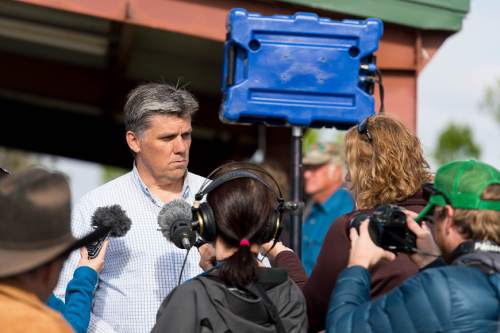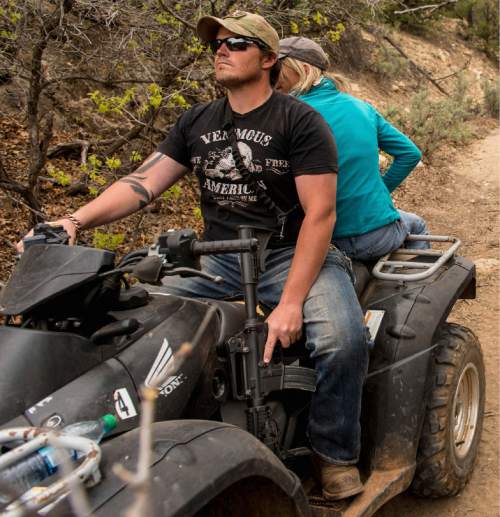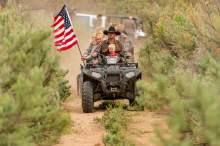This is an archived article that was published on sltrib.com in 2014, and information in the article may be outdated. It is provided only for personal research purposes and may not be reprinted.
Mark Brunk and Tim Rinehart were on a routine patrol in Arizona's Happy Camp Canyon when a man in a pickup roared past their Bureau of Land Management trucks, leaning out his window and angrily flipping them off.
The law enforcement rangers pulled over and got out their binoculars to watch him. The man stopped as well, climbed out of his truck –– and opened fire with a high-power rifle.
One bullet smacked the hood of Brunk's truck. Another shattered Rinehart's windshield, temporarily blinding him with fragments of glass. The rangers pursued the shooter as he drove away, but he escaped.
The shooting in June 2010 is among scores of threats and attacks against employees of the BLM and the U.S. Forest Service in Utah and Western states from 2010 to early 2014, according to reports compiled by High Country News.
The Colorado magazine used the Freedom of Information Act, or FOIA, to request reports from more than a hundred BLM and Forest Service offices from Alaska to New Mexico. The reports released so far show an ominous pattern of hostility and violence toward government employees before the BLM's high-profile armed standoff this spring with militia supporting Nevada rancher of Cliven Bundy.
Confrontations range from written and verbal threats to assaults, firebombs hurled at campground hosts and shots fired. BLM and Forest Service workers have been attacked at work and accosted in bars, threatened while grocery shopping and called at home.
Controversy over management of national forests and other federal lands "really isn't anything new," former BLM director Bob Abbey told High Country News. "The West has depended on and resented Washington, D.C., involvement in its activities since the first settlers."
But today's divisive political rhetoric over public lands "does lead to animosity and increased tension," Abbey said, "and there is a belief because of that rhetoric that it's OK to do certain things outside the law and some people believe that they're going to get away with it."
—
Threats in Utah • The High Country News began its investigation by filing a FOIA request for reports of harassment of BLM employees in southern Utah. The incidents it found included vandalism by an ATV driver who, apparently angry over the BLM banning motors on some trails, used his machine to tear up the yard of a BLM employee's home in San Juan County in 2010.
The magazine then filed its broader FOIA requests. Excerpts from thousands of pages of documents include these two confrontations in or near Utah:
• At the BLM in Moab, a man claiming to be a Vietnam War veteran "trained to kill people" said during his 2010 visit to the office that he wanted to "break some bones." After he left, one employee ran to the back of the office while others locked the door, afraid he would return.
The man reportedly told a Grand County sheriff's deputy investigating the incident that he sometimes sits on a nearby ridge and "waits with his .300 Winchester rifle for a BLM employee to drive by."
• Also in 2010, an inebriated man confronted a Forest Service road-grading crew in the Uinta-Wasatch-Cache National Forest, later ramming an employee's truck.
The man had gotten his pickup stuck on a rough road in a portion of the forest that is in Bear Lake County, Idaho. He yelled obscenities at the crew, complaining they weren't smoothing the road properly.
The man tried to pull the road grader's driver out of the cab. The driver, a Forest Service employee, kicked and punched him to keep him at bay.
Later that August day, the same man drove a Ford Bronco at another Forest Service employee who approached him in a campground. That employee "heard the man's (Bronco) accelerate and ... saw the man looking right at him," but dodged the Bronco.
When that employee climbed into a Forest Service truck to give chase, the Bronco's driver turned around and aimed at the forest service truck "at high rate of speed." The employee "anticipated a collision and put his vehicle into park and put (his) foot on the brake and leaned back to prepare for impact."
The Bronco driver swerved at the last second and clipped the side and front of the Forest Service truck.
In a threat more recent than the window covered by the High Country News investigation, two motorists brandished a gun at a federal wrangler who was driving in Juab County in May.
Government workers in western Utah stripped BLM logos from their vehicles following the incident, which occurred in the aftermath of the Bundy standoff and amid controversy over a surplus of wild horses on public lands in Utah.
The wrangler was driving a load of horses and burros north on Interstate 15 when a pickup pulled up alongside. The occupants, wearing hoods, held up a sign, apparently scrawled on a piece of paper, that read, "You need to die." One of the men pointed what appeared to be a Glock handgun at the wrangler.
—
Clashes around the West • Five days after the two Arizona BLM rangers dodged bullets in Happy Camp Canyon, 69-year-old Tracy Levi Thibodeaux, a former building inspector, was arrested at a rural post office while picking up his Social Security check. Investigators determined he was angered by the economic recession and blamed the federal government for some of his problems, believing it was harassing him and even trying to kill him.
Initially, he was found mentally unfit for trial. But that decision was later reversed, and in 2013, he was convicted of attempted murder and sentenced to prison.
Other threats around the West include rope nooses left for federal workers to scuffles in the dirt. Several workers have faced guns — or hands held like guns — pointed at them. In a few cases, federal employees have been fired upon.
In the summer of 2010, a Forest Service firefighter in California's Tahoe National Forest noticed a man on an embankment aiming a rifle at him. As the firefighter backed up, two shots were fired. As he drove away, another five shots were fired.
Investigators found cartridges, but the case is still open.
Last year in Carlsbad, New Mexico, two drug traffickers threatened a BLM employee after he refused to smuggle drugs in his government vehicle. The trafficker promised him $5,000 a run.
"The first male said I needed to work with them or they would kill me and my family," the worker said. "I again repeated that I would not work with them.
"The second male hit me across the bridge of my nose. I threw a few punches and took off running...across the parking lot."
Another man tried to grab a BLM employee's groin and launched into a profanity-laced, homophobic rant after a scuffle in Silverton, Colo. in 2012. He was angry about his lack of a permit for a backcountry ATV ride.
In another physical attack in 2012, two Forest Service employees on ATVs in the Bighorn National Forest in Wyoming tried to move around a slow-moving pickup. The driver eventually stopped and grabbed one of the employees around the throat, saying the feds "did not own the land."
And a BLM officer patrolling a rave in the desert near Black Rock City, Nev., in 2011 attempted to stop two men from urinating on a marked patrol vehicle. After he deployed his Taser, the crowd intervened, pinning the officer to the ground and hitting him in the back.
The employee finally escaped with the help of a man in a white cowboy hat and then, in distress, "began to vomit."
—
Roots of rebellion • It's difficult to tell how today's threats and violence compare to the past, said Jeff Ruch, executive director of Public Employees for Environmental Responsibility. Since the Oklahoma City bombing in 1995, the group has been filing FOIA requests to natural resource agencies for such reports
"In the early period, very few agencies report[ed] or even kept track of it," Ruch said. "Now, agencies like the Forest Service, they're reporting 400 or 500 incidents a year, whereas a few years ago with the same level of violence, if not more, they were reporting 30 or 40."
Ruch, Abbey, Boise State University professor John Freemuth and San Juan County Commissioner Phil Lyman explored the history of Western land disputes and solutions at an October discussion arranged by High Country News.
In the 1960s and '70s, new laws and regulations — such as the Endangered Species Act and the Federal Land Policy and Management Act — focused on conservation. They fueled the Sagebrush Rebellion, a political movement to increase local control of federal lands.
Tension today doesn't appear to have a single triggering event or policy change, Freemuth said, although the rhetoric "might be worse than it's ever been."
Ruch said he traces it to "a combination of a healthy dollop of political opportunism, but more importantly a thick crust of resource scarcity." Lyman pointed to federal bureaucracy.
"For example, the Forest Service now, when they close the road, they say, 'It's part of our 1991 travel plan.' People say, 'If it was passed in '91, why are you doing it now?' 'Well, we just hadn't gotten around to it until now.' And that gets people frustrated."
Lyman has been charged with conspiracy and illegally riding an ATV in San Juan County's Recapture Canyon for his role in a group protest ride in May. The BLM imposed a two-year ban on ATVs in the canyon in 2007, "yet we're going on seven years," Lyman said. "All we get (from the BLM) is, 'We're close, we're almost finished.'"
Abbey conceded the need for "more timely decisions," but said litigation is one cause.
"That's been one of the biggest changes in my career," he said. "From 2008 to 2012, there were over 250 lawsuits filed against Bureau of Land Management. One result is the inability of the agencies to move forward in a more timely manner and issue decisions and stand up to what the decisions reflect."
There must be consequences for those who threatened federal employees during the BLM roundup of Bundy's cattle, Abbey said. The BLM took action after Bundy had failed to pay grazing fees for decades, but released the cattle and left to defuse the armed standoff.
Broader solutions will require cooperation, Abbey said.
"The burden falls on all of us as public-land stakeholders, of trying to put our differences to the back of the room," he said, later adding: "We allow our minor differences to be barriers to accomplishing our mutual goals. We need to engage in a lively debate but remain focused on how much we hold in common."
This material was originally published in the Oct. 27, 2014, issue of High Country News, hcn.org.







